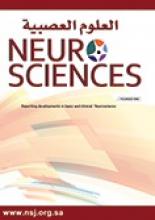Research ArticleOriginal Article
Open Access
Characteristics of the Functional Gait Assessment in adolescents with concussion
Abdulaziz A. Alkathiry
Neurosciences Journal July 2023, 28 (3) 165-169; DOI: https://doi.org/10.17712/nsj.2023.3.20220140
Abdulaziz A. Alkathiry
From the Department of Physical Therapy and Health Rehabilitation, College of Applied Medical Sciences, Majmaah University, Majmaah, Kingdom of Saudi Arabia
PT, PhD
References
- 1.↵
- Hannah TC,
- Kalagara R,
- Ali M,
- Schupper AJ,
- Li AY,
- Spiera Z, et al.
- 2.↵
- McCrory P,
- Meeuwisse W,
- Dvořák J,
- Aubry M,
- Bailes J,
- Broglio S, et al.
- 3.↵
- 4.↵
- 5.↵
- Davis GA,
- Anderson V,
- Babl FE,
- Gioia GA,
- Giza CC,
- Meehan W, et al.
- 6.↵
- Haarbauer-Krupa J,
- Lebrun-Harris LA,
- Black LI,
- Veliz P,
- Daugherty J,
- Desrocher R, et al.
- 7.↵
- Gallo V,
- Motley K,
- Kemp SPT,
- Mian S,
- Patel T,
- James L, et al.
- 8.↵
- Eagle SR,
- Asken B,
- Trbovich A,
- Houck ZM,
- Bauer RM,
- Clugston JR, et al.
- 9.↵
- Howell DR,
- Myer GD,
- Brilliant A,
- Barber Foss K,
- Meehan WP.
- 10.↵
- Alkathiry AA,
- Alsubaie SF,
- Alsalaheen BA,
- Whitney SL.
- 11.↵
- Wrisley DM,
- Marchetti GF,
- Kuharsky DK,
- Whitney SL.
- 12.↵
- Dannenbaum E,
- Bégin CL,
- Daigneault-Bourgeois É,
- Kwon Pak Yin N,
- Laferrière-Trudeau C,
- Mazer B, et al.
- 13.↵
- Karabin MJ,
- Sparto PJ,
- Rosano C,
- Redfern MS.
- 14.↵
- D’Silva LJ,
- Chalise P,
- Obaidat S,
- Rippee M,
- Devos H.
- 15.↵
- Joyce JM,
- Debert CT,
- Chevignard M,
- Sorek G,
- Katz-Leurer M,
- Gagnon I, et al.
- 16.↵
- Grove CR,
- Heiderscheit BC,
- Pyle GM,
- Loyd BJ,
- Whitney SL.
- 17.↵
- Youden WJ.
- 18.↵
- Price R,
- Choy NL.
- 19.↵
- Paul SS,
- Dibble LE,
- Walther RG,
- Shelton C,
- Gurgel RK,
- Lester ME.
- 20.↵
- Yang Y,
- Wang Y,
- Zhou Y,
- Chen C,
- Xing D,
- Wang C.
- 21.↵
- Beninato M,
- Fernandes A,
- Plummer LS.
- 22.↵
- Marques LBF,
- Moreira B de S,
- Ocarino J de M,
- Sampaio RF,
- Bastone A de C,
- Kirkwood RN
- 23.↵
- van Bloemendaal M,
- Bout W,
- Bus SA,
- Nollet F,
- Geurts ACH,
- Beelen A.
In this issue
Characteristics of the Functional Gait Assessment in adolescents with concussion
Abdulaziz A. Alkathiry
Neurosciences Journal Jul 2023, 28 (3) 165-169; DOI: 10.17712/nsj.2023.3.20220140
Jump to section
Related Articles
- No related articles found.
Cited By...
- No citing articles found.





